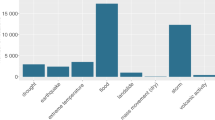Abstract
The increased interest for categorising countries at risk calls for an improved methodology allowing comparison of natural hazard impacts at a global level. A disaster is the intersection between a hazardous event, the elements at risk (population, infrastructures) and their vulnerability. In order to associate reported impacts with affected elements and socio-economic or geophysical contextual parameters, geographical location and extent of hazards is needed. The scope of this paper is to present improved automated procedures for a rapid map** of large disastrous hazard events (floods, earthquakes, cyclones and volcanoes) using Geographical Information Systems (GIS) and available global datasets. Up to 82% of the events and 88% of the reported victims could be geo-referenced and the results highlight both the potentialities and limitations of the methods applied.
Similar content being viewed by others
Abbreviations
- CNSS:
-
Council of the National Seismic System
- CRED:
-
Centre for Research on the Epidemiology of Disasters
- DEM:
-
Digital Elevation Model
- DFO:
-
Dartmouth Flood Observatory (University of Dartmouth, USA)
- EM-DAT:
-
Emergency Events Database (OFDA/CRED)
- FAO:
-
Food and Agriculture Organization
- FEWS:
-
Famine Early Warning System Network
- GIS:
-
Geographic Information System
- NGDC:
-
National Geophysical Data Center
- OFDA:
-
Office of US Foreign Disaster Assistance
- PREVIEW:
-
Project of Risk Evaluation, Vulnerability, Information & Early Warning (UNEP/GRID-Geneva)
- UNEP/GRID-Geneva:
-
United Nations Environment Programme/Global Resource Information Database – Geneva
- VEI:
-
Volcanic Explosivity Index
- WRI:
-
World Resources Institute
References
Allen, R. G., Pereira, L. S., Raes, D., and Smith, M: 1998, Crop evapotranspiration – Guidelines for computing crop water requirements, FAO Irrigation and drainage paper 56, http://www.fao.org/docrep/X0490E/x0490e00.htm#Contents.
Artan, G. A., Restrepo, M., Asante, K., and Verdin, J.: 2002, A Flood Early Warning System For Southern Africa, Pecora 15/Land Satellite Information IV Papers, http://www.isprs.org/commission1/proceedings/paper/00030.pdf.
P. Blaikie T. Cannon I. Davis B. Wisner (1996) At Risk: Natural Hazards, Peoples Vulnerability and Disasters Routledge London and New York
B.A. Bolt W.L. Horn G.A. Macdonald R.F. Scott (1975) Geological Hazards Springer-Verlag Berlin
J.I. Clarke D.W. Rhind (1992) Population Data and Global Environmental Change IISC/UNESCO Paris
Coburn, A. W., Spence, R. J. S., and Pomonis, A.: 1991, Vulnerability and Risk Assessment, UNDP Disaster Management Training Program, UNDP/UNDRO
FAO: 2001, Asia FIVIMS For Disaster Preparedness, In: Report of the FAO Asia-Pacific Conference on Early Warning, Prevention, Preparedness and Management of Disasters in Food and Agriculture, Chiangmai, Thailand, Annex XIII, http://www.fao.org/DOCREP/005/AC120E/AC120E00.HTM.
C. Funk J. MichaelsenJ. Verdin G. Artan G. Husak G. Senay H. Gadain T. Magadazire (2003) ArticleTitleThe collaborative historical African Rainfall Model: description and evaluation Int. J. Climatol. 23 47–66
Guha-Sapir, D. and Below, R.: 2002, The quality and accuracy of disaster data: a comparative analyses of three global data sets, technical document, The ProVention Consortium and the Disaster Management Facility, The World Bank, WHO Centre for Research on the Epidemiology of Disasters, University of Louvain School of Medicine.
G.J. Holland (1980) ArticleTitleAn analytic model of the wind and pressure profiles in hurricanes Monthly Weather Rev. 108 1212–1218
IFRC (International Federation of the Red Cross and Red Crescent Societies): 2003, World Disasters Report 2003, Kumarian Press, Bloomfield, CT, http://www.ifrc.org/publicat/wdr2003/.
H. Kawasumi (1951) ArticleTitleMeasures of earthquake danger and expectancy of maximum intensity throughout Japan as inferred from the seismic activity in historical times J. Soc. Precis. Eng. 29 469–482
Mouton, F., Nordbeck, O.: 2003, Cyclone database manager : a tool for converting point data from cyclone observations into tracks and wind speed profiles in a GIS, University of Geneva, http://www.grid.unep.ch/activities/earlywarning/download/cylconesmodeling.pdf.
C.G. Newhall S. Self (1982) ArticleTitleThe volcanic explosivity index (VEI): An estimate of explosivity magnitude for historic volcanism J. Geophys. Res. 87 1231–1238
Peduzzi, P., Dao, H., Herold, C. and Rochette, D.: 2001, Feasibility Study Report On Global Risk and Vulnerability Index Trends per Year (GRAVITY), scientific report prepared for the UNDP/BCPR, Geneva, Switzerland.
Peduzzi, P., Dao, H. and Herold, C.: 2002, Global Risk And Vulnerability Index Trends per Year (GRAVITY), Phase II: Development, analysis and results, scientific report prepared for the UNDP/BCPR, Geneva, Switzerland.
Schloemer, R.W.: 1954, Analysis and synthesis of hurricane wind patterns over Lake Okechobee, Florida. Hydromet. Rep. 31, Dept. of Commerce, Washington, DC.
T. Simkin L. Siebert (1994) Volcanoes of the World Geoscience Press Tucson, AZ
K. Smith (1996) Environmental Hazards, Assessing Risk and Reducing Disaster Routledge London and New York
G.A. Tobin B.E. Montz (1997) Natural Hazards, Explanation and Integration The Guildford Press New York
UNDP: 2004, Reducing Disaster Risk. A Challenge for Development, UNDP, Bureau for Crisis Prevention and Recovery, New York, http://www.undp.org/bcpr/disred/rdr.htm.
UNDRO (United Nations Disater Relief Coordinator): 1979, Natural Disasters and Vulnerability Analysis, Report of Expert Group Meeting (9–12 July 1979), UNDRO, Geneva.
Verelst, Luc: 1999, Recommendations for Geo-referencing EM-DAT Data Base, Consultancy Report prepared for the Asia FIVIMS Project and the CRED, Rome.
Author information
Authors and Affiliations
Corresponding author
Rights and permissions
About this article
Cite this article
PEDUZZI, P., HEROLD, H.D.C. Map** Disastrous Natural Hazards Using Global Datasets. Nat Hazards 35, 265–289 (2005). https://doi.org/10.1007/s11069-004-5703-8
Received:
Accepted:
Issue Date:
DOI: https://doi.org/10.1007/s11069-004-5703-8




